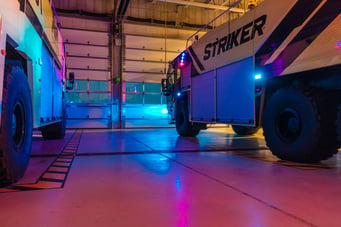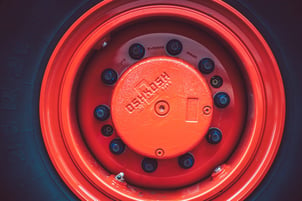
Cold weather brings on a whole new set of changes and challenges for any kind of vehicle. The Striker® aircraft rescue and fire fighting (ARFF) vehicle is no different. Below is a guide on key check points to help ensure your Striker ARFF is operation ready even in the most frigid weather.
Verify Your ARFF Truck Batteries are Working at Full Capacity
The batteries onboard the Striker ARFF vehicle are lead acid batteries with lead plates in electrolyte liquid. This creates an electrochemical reaction that creates a charge to the battery. When the batteries are hot, chemical activity inside the batteries accelerates. However, when the batteries are cold, chemical activity in the batteries are slowed down. That’s why batteries often feel stagnant during the winter months even though they are still performing.
You should perform a load test on your ARFF batteries prior to winter, which is the optimal way to validate the batteries are strong enough to withstand the frigid weather. It’s also a great idea to keep a spare battery in stock in case of an emergency. Keep the spare battery stored in a temperature-controlled environment and periodically charge the battery to ensure a long battery life.
Are You Mixing ARFF Vehicle Engine Coolant at the Correct Ratio?
When mixing ARFF vehicle engine coolant at the correct ratio, it is important to insert the proper ratio of water to antifreeze. To find the correct ratio, consult your Oshkosh Striker service manual or your engine manufacturer’s service manual for the proper ratios. Following the manual's instructions will provide optimal coolant protection for temperatures experienced at your airport.
Is Your Compartment Winterization System Working Properly?
The winterization system is a diesel-fueled heating system. The system heats water and circulates it through heat exchangers located in the compartments of the Striker ARFF. The heat exchangers have a fan attached to them, which transfers the heat from the water to the air inside the compartment. This keeps the compartments warm and prevents firefighting components, such as ball valves, piping, and nozzles, from freezing.
If your ARFF truck is equipped with a compartment winterization system, you should periodically engage the system to verify it is working correctly. To do so, you must first place the compartment heater switch in the ON position. Then, allow one to two minutes for the heater to start operating. During non-heating months, you should still switch the heating system on for about ten minutes every four weeks, which will help ensure proper start up and function once cold weather hits.
Allow the system to circulate warm coolant, and check the heat exchanger in the compartment to verify the fan is functioning correctly and that warm air is blowing. To shut down the heater, place the compartment heater switch to the OFF position. The blower will continue to run until the heater fumes are thoroughly exhausted. For additional information, reference the maintenance section of your Striker service manual.
The following are simple maintenance tips you can follow to ensure your winterization system operates properly:
Maintain ARFF Truck Tire Pressure
Temperature change can cause a dramatic change in tire pressure and overall performance. As temperatures drop, the molecules inside tires move slower and crowd closer together, causing tire pressure to decrease. During high temperatures, molecules move faster and take up more space, causing tire pressure to increase. To find the correct tire pressure for your truck, reference the data plate located on the driver’s door or in the cab. Be certain to maintain the correct tire pressure during the winter months for optimum vehicle performance.
It’s also important to rotate the tires if uneven wear is identified. Replace any tire with cuts in the sidewall which penetrate the cord or have a tread depth less than 4/32 of an inch on steering axles or 2/32 of an inch on a non-steering axle.
Controlling ARFF Vehicle Idling and Wet Stacking
It is important to be mindful of how often an ARFF truck engine is idling. Extended idling of a diesel engine impacts the engine's ability to warm up fully. This can influence your vehicle’s emissions system performance and cause wet stacking. Wet stacking occurs when the engine is too cold to burn all the fuel, causing unburned fuel to collect on cylinder walls and exhaust components. This unburned fuel, which appears as a black oily substance, can ooze from the exhaust manifold, turbo charger, and exhaust piping. Wet stacking can cause damage to the engine if not properly cared for over a long period of time.
When the vehicle is driven, the engine’s exhaust temperature is elevated, and produces enough heat to keep emissions systems working properly. Limiting the idle time of the engine, operating the vehicle under load (pumping or driving), or placing the engine in high-idle will help bring your engine to normal operating temperatures reducing the risk of wet stacking.
As the seasons change, so does your maintenance regimen. Some of these suggestions might seem obvious, but it is important to continually perform checks on your Striker ARFF to ensure it is operationally ready no matter what extreme temperature you’re up against.
For any additional questions, please reach out to our team by email at customersupport@oshkoshcorp.com. Emailing this address will open and assign a ticket to the appropriate team member, who will happily follow up and answer any questions you have.
.webp)



